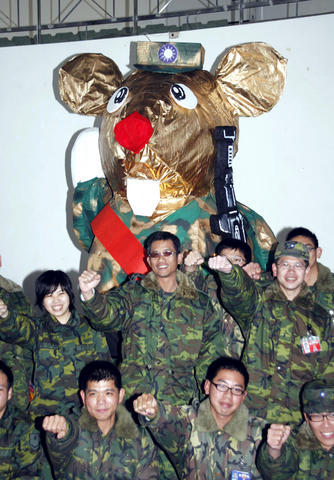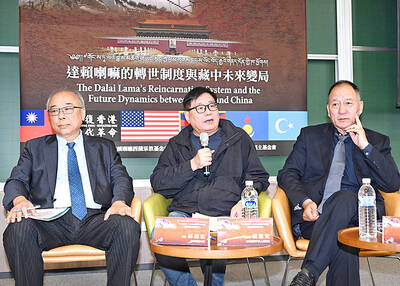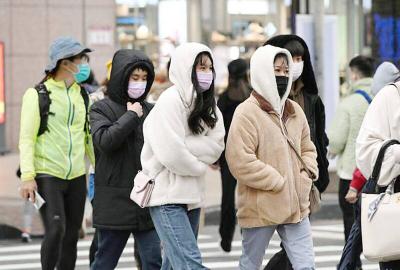The military's new air defense system was hurt somewhat by an intelligence leak to China, but its key technology was not compromised, a Ministry of National Defense (MND) official said yesterday.
The Po Sheng ("Broad Victory") system -- a sophisticated command, control and communications network that the government is purchasing from US defense contractor Lockheed Martin -- was one of the targets highlighted in an espionage affidavit filed earlier this month against a Pentagon analyst in a US court.
The analyst, Gregg Bergersen, was accused of providing classified information to Kuo Tai-sheng (

PHOTO: CNA
intact
Speaking to reporters yesterday, ministry spokesman Yu Sy-tue (
"The US provides Taiwan with the system's infrastructure, but Taiwan still controls the key integral technology," he said.
"The damage was within our expectations," he said.
A Defense News report said ministry officials were particularly concerned that a program to modernize its C4ISR network might have been compromised.
C4ISR stands for command, control, communications, computers, intelligence, surveillance and reconnaissance, all considered crucial to winning any military confrontation.
The Defense News reported that "Bergersen managed negotiations on the Communications and Information Security Memorandum of Agreement, which allows the United States to release the Type 1 cryptography techniques that would be used for US-Taiwan communications during a war."
It added that "If true, there are concerns that China now has access to the crypto/keying material/algorithms that could allow Beijing to penetrate Taiwan and US networks."
knowledge
Yu acknowledged that Bergersen had knowledge of the Po Sheng system and said he met with Taiwan's defense ministry on that project, and on other issues, which he declined to specify.
He said that Kuo had never been in contact with the ministry.
The Chinese government has called the accusations of espionage in the Po Sheng affair groundless and accused the US of "Cold War thinking."
The Po Sheng system would be a critical element of Taiwan's defense in the event of an attack from China.
Additional reporting by staff writer

ALIGNED THINKING: Taiwan and Japan have a mutual interest in trade, culture and engineering, and can work together for stability, Cho Jung-tai said Taiwan and Japan are two like-minded countries willing to work together to form a “safety barrier” in the Indo-Pacific region, Premier Cho Jung-tai (卓榮泰) yesterday said at the opening ceremony of the 35th Taiwan-Japan Modern Engineering and Technology Symposium in Taipei. Taiwan and Japan are close geographically and closer emotionally, he added. Citing the overflowing of a barrier lake in the Mataian River (馬太鞍溪) in September, Cho said the submersible water level sensors given by Japan during the disaster helped Taiwan monitor the lake’s water levels more accurately. Japan also provided a lot of vaccines early in the outbreak of the COVID-19 pandemic,

Kaohsiung Mayor Chen Chi-mai (陳其邁) on Monday announced light shows and themed traffic lights to welcome fans of South Korean pop group Twice to the port city. The group is to play Kaohsiung on Saturday as part of its “This Is For” world tour. It would be the group’s first performance in Taiwan since its debut 10 years ago. The all-female group consists of five South Koreans, three Japanese and Tainan’s Chou Tzu-yu (周子瑜), the first Taiwan-born and raised member of a South Korean girl group. To promote the group’s arrival, the city has been holding a series of events, including a pop-up

TEMPORAL/SPIRITUAL: Beijing’s claim that the next Buddhist leader must come from China is a heavy-handed political maneuver that will fall flat-faced, experts said China’s requirement that the Dalai Lama’s reincarnation to be born in China and approved by Beijing has drawn criticism, with experts at a forum in Taipei yesterday saying that if Beijing were to put forth its own Dalai Lama, the person would not be recognized by the Tibetan Buddhist community. The experts made a remarks at the two-day forum hosted by the Tibet Religious Foundation of His Holiness the Dalai Lama titled: “The Snow Land Forum: Finding Common Ground on Tibet.” China says it has the right to determine the Dalai Lama’s reincarnation, as it claims sovereignty over Tibet since ancient times,

Temperatures in some parts of Taiwan are expected to fall sharply to lows of 15°C later this week as seasonal northeasterly winds strengthen, the Central Weather Administration (CWA) said today. It is to be the strongest cold wave to affect northern Taiwan this autumn, while Chiayi County in the southwest and some parts of central Taiwan are likely to also see lower temperatures due to radiational cooling, which occurs under conditions of clear skies, light winds and dry weather, the CWA said. Across Taiwan, temperatures are to fall gradually this week, dropping to 15°C to 16°C in the early hours of Wednesday